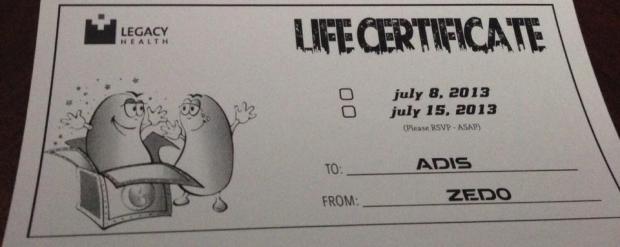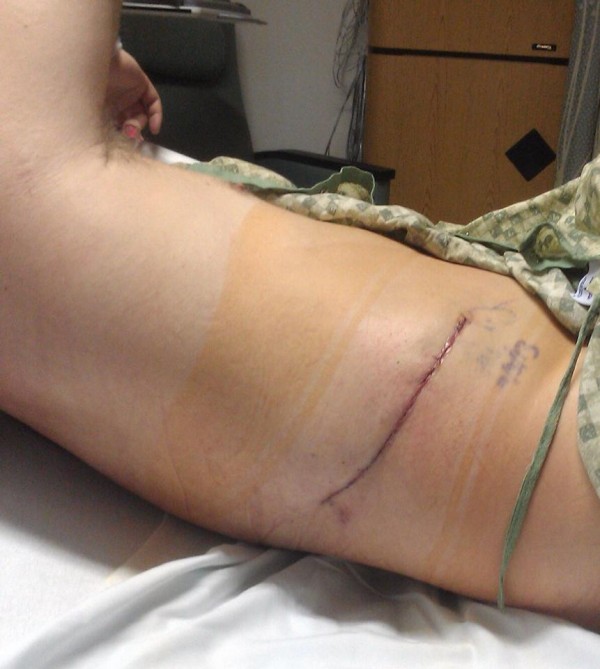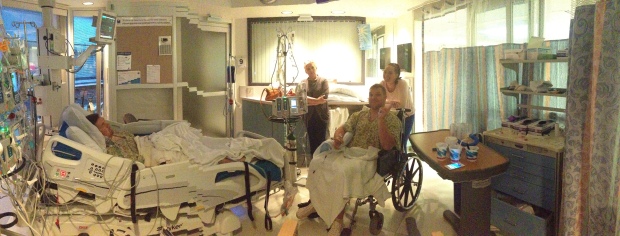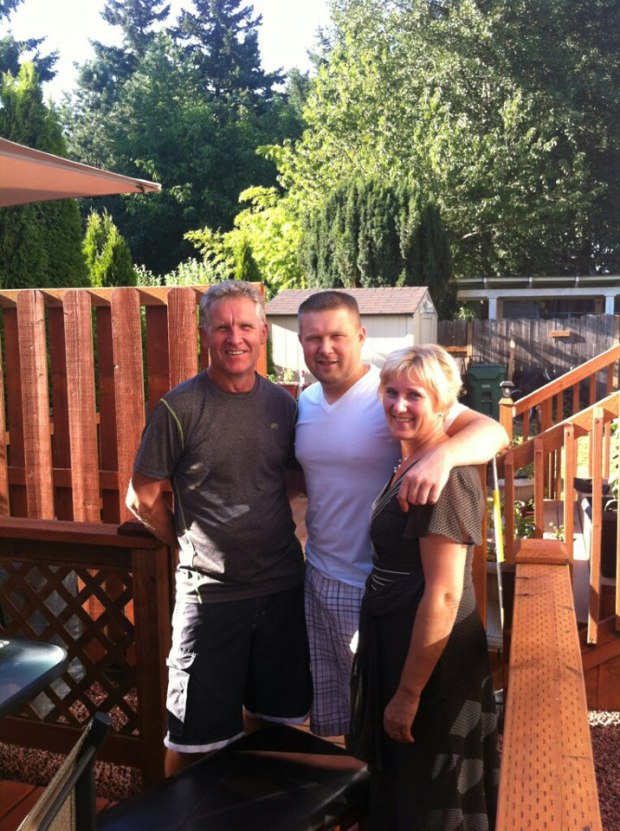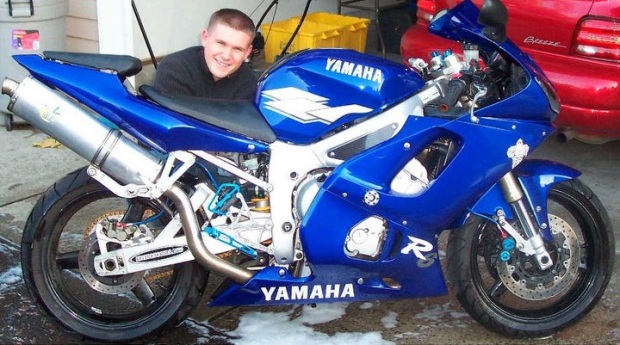The Human Moxie
Archive for category MARCH 2014
The Gift of Life – Part III, The Conclusion
Posted by Jenny Cantu in MARCH 2014 on March 28, 2014
[…continued from Part II…]
zedin was sitting at his work desk when Cory called on the 27th of May last spring. Gripping his phone firmly, he anxiously waited for Cory to tell him the final results of his testing.
He would not only need three of the six proteins in his blood to match Adis’s, but he must have two fully operating kidneys in order to donate one. Some people are born with a single kidney (termed renal agenesis) and others have kidney dysplasia, a condition where two kidneys are present but only one functions correctly. If the CT showed that Azedin did not have two working kidneys or the labs revealed that only one was healthy, Adis would remain on the national waiting list indefinitely. Time was running short.
‘I just want to let you know I have all your results back and…’ Cory paused. Azedin’s anxiety grew with every passing moment. “…And?” he thought impatiently. He would be heartbroken if Cory didn’t deliver promising news. “…You’re a match!” There was silence on his end of the telephone line. Azedin couldn’t believe what he heard. “We’re a go!” she exclaimed as she excitedly began to list the available dates for surgery.
Out of the six proteins in Azedin’s blood, all six were a complete match; typical of what is found in blood samples between twins. Kidney function tests and the final CT exam proved Azedin had a life-saving kidney to donate to his brother. He kept the results private as he and Adna planned Adis’s surprise birthday gift, the gift of a lifetime, with just two days to spare.
The evening of the gathering, Adis was in his living room telling jokes and laughing with family members when Azedin approached him with his surprise birthday gift. Azedin created a personal coupon book to break the news to his brother and the rest of the family. The first coupon was a voucher for $150 toward a new motorcycle jacket of his brother’s choice. The second coupon was cardstock cut into the shape of a kidney and its anatomical parts sketched onto its surface. The final coupon was a “Life Certificate” Azedin designed where he listed two surgery dates for Adis to choose from.
You can watch Adis’s reaction here.
The family was overwhelmed by the news. Adis’s wife and mother were both overcome by emotion. At first, Adis was confused and surprised, then sad. He tried to be happy, but he could hardly conceal his mixed emotions. Adis was aware that Azedin had been inquiring about the process of organ donation, but he didn’t know his brother was seriously exploring the option to become a donor himself. And Adis didn’t question Azedin about any involvement in the matter, concerned that he might instigate unintentional pressure upon his sibling. In fact, Adis preferred that his family not become implicated in the donor process, fearing he could never repay them should any of his loved ones ever need a kidney transplant in the future. Once Adis came to terms with the results, he was looking forward to better days.
While Adis was willing to continue dialysis for as long as necessary, he knew it was only a temporary solution to an ongoing problem. The first month Adis was on peritoneal dialysis (CAPD), he was manually filtering his blood four times a day, carrying small bags of cleaning solution with him everywhere he went. It was inconvenient and sanitation was extremely imperative to avoid possible peritoneal infection. Then he was switched to a different dialysis treatment (APD) where his blood was filtered and cleansed by a cycler while he slept at night only. He continued this method for four more months. While it is an efficient treatment, undergoing dialysis on a daily basis can negatively impact the body and shorten one’s life span. A kidney transplant was the ideal solution to prolonging his life.
The last night before surgery, Adis was feeling anxious, but continued to think optimistically. Unfortunately, his worst nightmare occurred and something went terribly wrong. He was awakened in the middle of the night when he sensed his clothes and bed sheets were drenched! After eliminating a few possible reasons as to why his garments could be wet, he frantically jumped out of bed to find that the tube that connected to his port had somehow detached and fluid gushed out. He had been warned by specialists to take extreme care at night when sleeping to avert possible contamination, essentially delaying surgery. He immediately contacted his home health nurse who arrived around three o’clock in the morning to assist Adis at home. After phone calls to doctors were made and extra precautions were taken to avoid infection, the nurse left. Adis was unable to fall asleep again as he stared at the clock, waiting for any signs or symptoms of infection to occur after the untimely ordeal. Hours passed sluggishly until morning finally arrived and Adis received word that he was cleared to proceed with surgery.
Azedin and Adis were scheduled for their operations respectively on the morning of July 8th. Their parents were nervous. They looked on at their adult children as they were wheeled into the surgery prep room, frightened by thoughts of anything that could go awry. Azedin recalls being more than ready for the procedure, trusting his life into God’s hands. A little apprehensive at first as to what the future would hold for his younger brother, Adis made a conscious effort to resume meditating on positive thoughts. In the surgical prep room, Azedin’s fiancée was standing nearby while the couple chatted with Adis and his wife. The anesthesiologist interrupted their conversation with an announcement directed at Azedin: “Here comes the good stuff!” Azedin looked to his right where his older brother lay on a stretcher wearing a surgical cap as he was undergoing preparations for surgery also. He continued to scan the space when he exchanged glances with his sister in law. Ultimately, he rested his eyes on his soon to be wife and managed to utter his final observation: “You guys are all dizzy right now.” Those were his last words to his family before falling into a deep sleep.
LIVE! video taken from the day of surgey can be viewed here.
A large incision was made on the right side of Azedin’s abdominal cavity where surgeons removed his right kidney. Next, they cleaned the kidney and flushed a water-like solution through its parts before placing it in an ice chest. Adis was in the next operating room already sedated and waiting for his life-saving organ to be transplanted. Though Azedin’s procedure was completed in just over sixty minutes, the entire process lasted about four hours.
Adis’s body embraced the new kidney immediately. Abnormally elevated creatinine levels plummeted drastically and continued to do so until they finally returned to normal the next evening following surgery. His swelling was gone and for the very first time in many years, he felt great. When Azedin learned how well his brother was responding after surgery, he was very grateful. “I don’t really show my emotions very much, but there’s just times where you can’t hold yourself back; whether you want to or however strong you want to be, you just can’t be. Emotions run.”
Azedin was released two days after surgery and within a week, he was walking around comfortably. Three weeks after surgery, he was already riding a bike again. He doesn’t feel any different than before nor does he sense that something is missing on the inside. Other than the large scar that wraps around his right side as a daily reminder, his everyday life continues unaffected by the procedure. He is still as active as before, enjoying sports like snowboarding, football, soccer, and basketball. For safety measures, Azedin undergoes an annual physical and completes lab tests to ensure his internal processes are balanced and functioning normally.
As for Adis, the first three months after completing surgery, he went in for checkups three times a week to ensure his body was not rejecting the kidney. His visits gradually decreased to a checkup once a month until his one year anniversary. Adis takes two pills in the morning that help suppress the white blood cells, preventing lupus from potentially returning; a significant change from the numerous remedies and prescription bottles he was once accustomed to. When he reflects on photos of himself captured on several different occasions in the past, he vividly recalls how despite his smile, he was feeling miserable during that little glimpse of time. And yet he would often remember that it could always be worse.
On Azedin’s wedding day in November of last year, Adis stood by his brother as his best man. During the reception, Adis shared a spontaneous, emotional speech that moved over three hundred guests to tears in that reception hall. A slideshow organized by Adis followed shortly after. As Azedin viewed the pictures next to his bride, the memories he shared with his brother as they grew older together were even more meaningful. Realizing that his brother could have possibly not survived to witness his wedding day or have the opportunity to create more memories together gripped his heart. “I realized how quickly things can disappear in life. Something that’s come up can take you down so quickly. Adis was fine and then suddenly lupus just took over his body. It opened my eyes to appreciate what I have and I’m beyond thankful.”
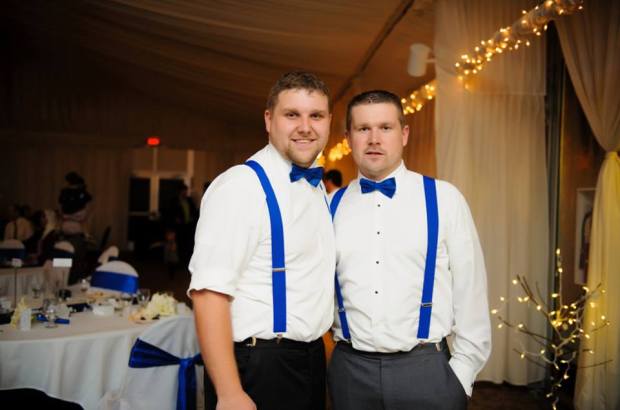
Azedin and Adis (right) celebrating life and love on Azedin and Adna’s wedding day. (Photo Courtesy of Victor Saidov Photography).
The overall experience has made Azedin sensitive to those struggling with lupus and other illnesses as well as compelled him to encourage others to become organ donors. He became involved in an online group called the Living Kidney Donor Network where he shared a little bit about his story. In fact, his story even motivated a woman he doesn’t know to become an anonymous living donor. He hopes to raise more awareness about lupus and inform others that life is still as full and rewarding with a single kidney.

Through thick and thin, a very thankful husband lovingly dips his supportive and stunning bride, Adna. (Photo courtesy of Victor Saidov Photography).
As for the gift that Azedin gave Adis, the gift of life leaves Adis at a loss for words. “Thanking somebody for something like this is almost silly. How do you repay somebody for saving your life?” With Azedin’s healthy kidney intact, Adis has the chance to live at least twenty years or more. “We all have to go some day,” Adis reasons. “Some go sooner. Some go later. Visit those who are sick. Put yourself in their shoes. You may never fully understand, but it might give you a little different perspective on life. Do the things you love. Don’t stress over insignificant matters. Have fun and laugh. Find peace and find faith. Appreciate life.”
autoimmune disorder, awareness, brothers, donate life, faith, family, health, inspiration, kidney, kidney failure, kidney transplant, life, Lupus, organ donor, organ transplant, stories, transplant, wedding
The Gift of Life – Part II
Posted by Jenny Cantu in MARCH 2014 on March 13, 2014
[…continued from Part I…]
en-year-old Adis and his then six-year-old -brother, Azedin, were separated from their father as the boys and their mother endured six terrifying months in a concentration camp in Bosnia. The trio miraculously escaped flying bullets, falling mortars, and exploding grenades while desperately running through a forest in hiding. When the broken family finally arrived in Slovenia as refugees, they heard no word on the condition of their father, of his whereabouts, or if he was even alive. And they didn’t for the next two years. One morning in 1994, he unexpectedly appeared at their refugee camp as his heartsick family blinked at him beyond disbelief. After their emotional reunion, returning to Bosnia was clearly not an option. They sought help from and were reunited with a relative who settled in the upper northwest of the U.S. just the year before after also fleeing from their war-stricken country. The traumatic experiences would be enough to last a lifetime, but sadly, Adis was forced to contend for his life once more.
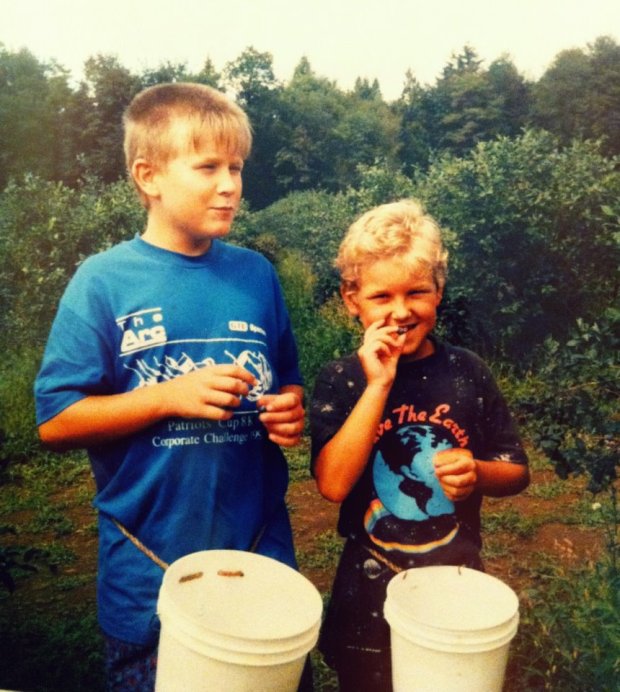
The boys enjoy picking berries at a blueberry farm after moving to the United States. (Photo courtesy of Azedin).
Ten years later, Adis and his young wife returned to their home in the northwest after vacationing together on the East Coast. He noticed a small rash with little red speckles on both of his cheeks. After the dermatologist examined the area of interest, Adis was told it was a possible outbreak of a skin condition called rosacea. Rosacea seemed innocuous at first even when he learned that his blood test results were slightly irregular. Lab tests revealed proteins not normally found in urine samples; however, because the figures were still within normal range, the new developments did not seem critical – at least not yet.
The first three years were calm with the rash being the main sign of any possible health issue, but another dip in Adis’s health put him on a winding downward path. Eventually, doctors discovered that Adis’s immune system was damaging his kidneys. Lymphocytes, or white blood cells, normally circulate through the bloodstream searching for foreign contaminants that help fight against illnesses, for example, the common cold or flu. Instead, his body determined his kidneys were a foreign substance. The lymphocytes erroneously attached themselves to his kidneys, aggravating them and hindering them from functioning properly. While this battle was occurring in his body, signs and symptoms were not yet manifested outwardly. “I was feeling fine and I would be feeling fine until my kidneys got to a point where I didn’t feel fine anymore. By then, it was almost too late,” he says.
After probing into his health more closely, doctors performed two biopsies: they took a sample of his skin and one from his kidney. Based on the activity present in his body and the findings from the biopsies, medical professionals established he had signs consistent with those of lupus patients and diagnosed him with systemic lupus erythematosus (SLE).
The kidney biopsy revealed his kidneys were only 45% functional. While the doctors advised he may need to undergo dialysis should his kidneys continue to deteriorate, Adis was somewhat in denial while clinging to the hope that his health would improve before it got worse. Up until that point, Adis had been drinking herbal teas and utilizing natural anti-inflammatory medicines. But as his health waned, he was prescribed a variety of different medicines in an attempt to keep his body in balance. His kidney function continued to lessen, down to 35% and then 30%. He rapidly began to show signs of disease and began to experience symptoms. His body retained water to the point of pitting. (With his finger he would press on his skin and a temporary impression remained after removing his finger from its surface). He frequently felt hunger pains knowing if he consumed any amount of food, it would be just like feeding poison to his body. The bathroom was his loyal companion as he was constantly nauseous, sometimes vomiting ten times a day, if not more.
The medicine eventually was of no use. Adis was not improving and options were few. Doctors recommended a chemotherapy treatment on a monthly basis for six months in 2011. The treatment would circulate through the kidneys and “burn off all the white cells that are on the kidneys to relieve them” of the constant stress. Then they would be able to operate to some degree without the lymphocytes hoarding the kidneys. Since the lymphocytes were very aggressive, they scarred the kidney tissue, essentially drying out the areas affected (similar to the likes of a prune), hindering filtration and normal function.
Adis’s condition improved during the course of the treatment, but after six months of chemotherapy, lupus was very active in his system again. He was unable to take medicine or treat his symptoms after completing chemotherapy so that his body would have time to recover.
With decreased kidney function, he had changes in urination, an alkaline or metallic taste in his mouth, ammonia breath, chills, shortness of breath, intense cramps, trouble focusing, and extreme fatigue. Edema worsened and frequent vomiting was brutal. He consistently felt tired and even though he slept very long hours at night, he would wake up as if he had never slept at all.
Through it all, his daily routine didn’t miss a beat. Though on light duty, Adis continued overseeing a port management company he worked for full time while keeping all of his medical appointments. He was also the president of a Bosnian non-profit organization in his community and was dedicated to serving them unwaveringly. His faith in God grounded his emotions. Laughter and a positive mindset helped him look beyond his circumstances. He maintained his active lifestyle playing sports, meeting with friends, joining them on spontaneous trips, and riding his motorcycle. Riding his motorcycle helped him forget about everything and cleared his mind. “I basically did not let lupus stop me from doing anything. I just kept going to keep my mind from thinking about how sick I was.” Adis kept moving and kept smiling.
A second biopsy of his kidney was later completed showing his kidney function had drastically decreased to 15% – both kidneys were equally affected and his body was in serious distress. Dialysis was his last resort or he would surely die. Without his kidneys normally filtering his blood of the daily toxins, Adis’s potassium levels would increase to dangerous levels. It was only a matter of time before he would go into cardiac arrest. He remembers times when he would be contacted at home by a nurse and notified to report to the nearest emergency room immediately because his potassium levels were dangerously high. His body was no match for the complications the doctors now referred to as lupus nephritis.
Finally, Adis had had enough. His symptoms had become very unbearable and had no other choice but to agree to dialysis. Once he started dialysis in early 2013, he was placed on the national waiting list in hopes of receiving a kidney from an anonymous donor.
To put Adis’s grave situation into perspective, the National Kidney Foundation’s website states that every twenty minutes, a patient is added to the kidney transplant list; almost 2,500 patients are added to the list every month. Fourteen people die every day while waiting for a kidney transplant. These figures are not just numbers, but souls. Death was knocking at Adis’s door…
[…to be continued…]
awareness, donate life, faith, family, health, inspiration, kidney, kidney transplant, Lupus, organ transplant, stories, world kidney day


